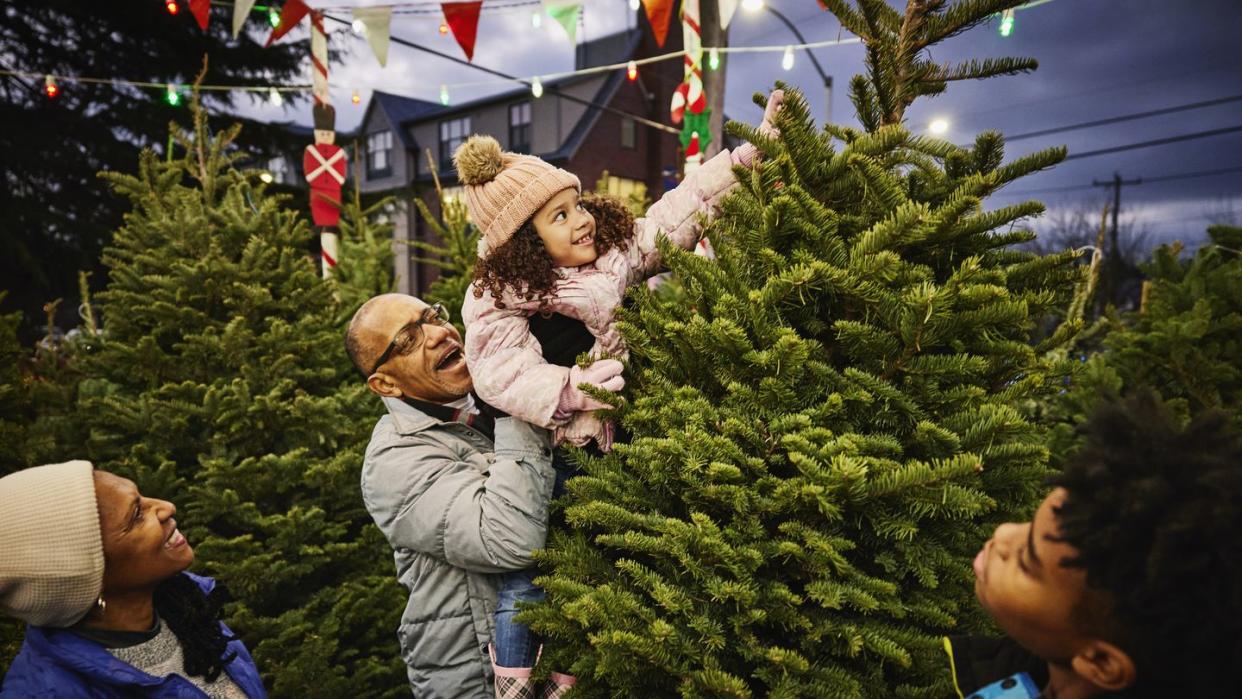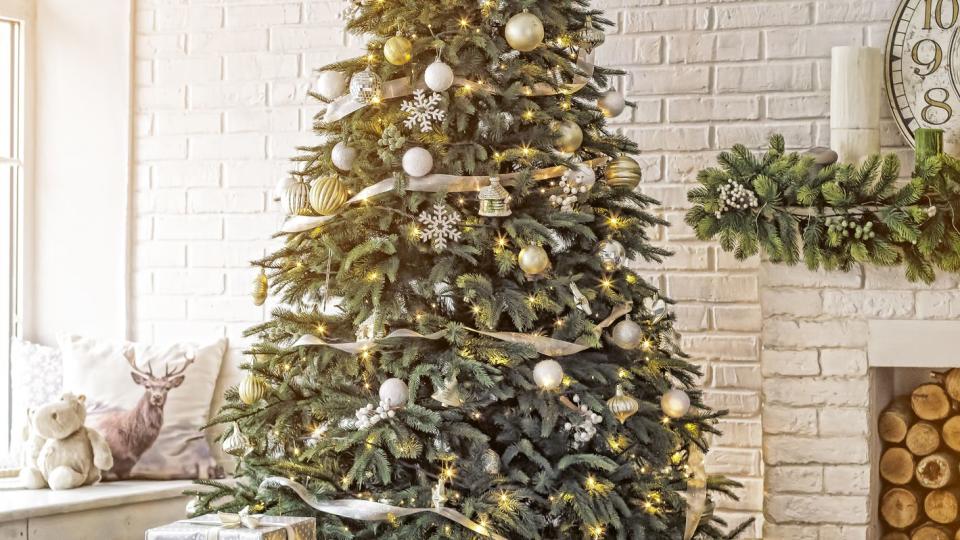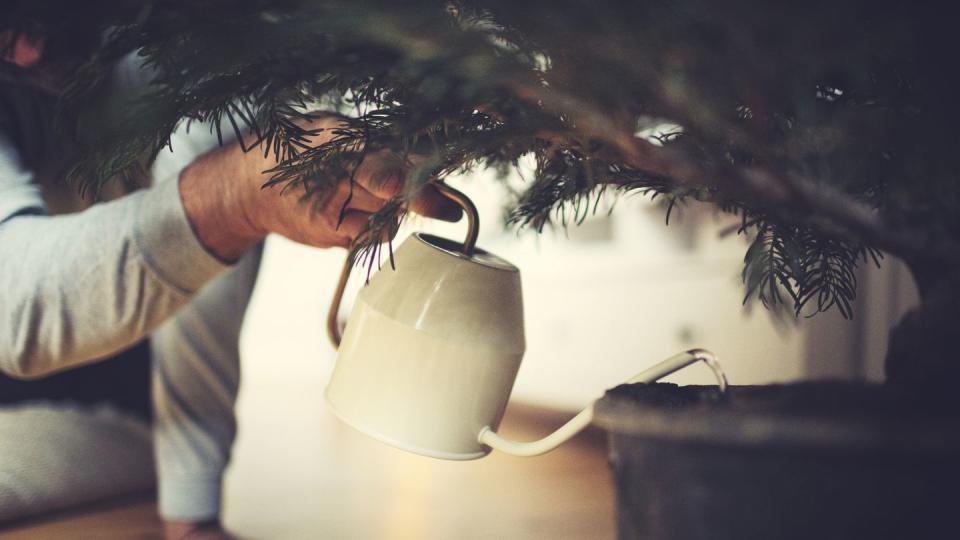Here's How to Pick the Perfect Tree and How to Keep It Lasting the Entire Holiday Season

"Hearst Magazines and Yahoo may earn commission or revenue on some items through these links."
If you celebrate Christmas, you know there's nothing like having a real Christmas tree in your home. The adventure of heading to your local Christmas tree farm, picking out the perfect fir, pine or spruce, then bringing it home is half the fun — but the magic really begins once your tree is all dressed up for the holidays.
To keep your tree's sparkle alive for as long as possible indoors, the home care experts at the Good Housekeeping Institute have rounded up our best tips for making sure that your tree is still looking fresh come Christmas morning.
How long do real Christmas trees last?
With proper care, most real Christmas trees should last at least five weeks or more.
That means, if you decorate for Christmas in late November, your tree should easily survive beyond the holiday festivities. However, we suggest buying your Christmas tree during the first week of December to ensure you aren't left with a dried up, brittle tree come December 25.
Species
Among the most popular Christmas trees are pines, spruces and firs. More specifically Scotch Pines, Blue Spruces and White Spruces are other species of Christmas trees that are popular for the season Fraser and Balsam Firs are some of the most popular due to their shape, size, and longevity.
If you live in a small home or apartment, and don’t have enough space for a large tree, tabletop Christmas trees such as the Farmstand Norfolk Pine or Fragrant Holiday Lavender Tree are great options. They also come pre-lit and decorated, which helps to save on time.
§ Table-top Christmas trees are also a great option if you have small children or pets, and need to keep holiday décor out of reach.
What to consider when buying a Christmas tree
o This holiday season when you are shopping for a Christmas tree, whether in person at a farm or nursery, or online at 1-800-Flowers.com, I recommend keeping in mind the following:
When are you planning to purchase your tree?
In order to keep your tree looking fresh and vibrant throughout the holiday season, I recommend purchasing your evergreen about four weeks before December 25.
However, if you have time to properly care for it, you can purchase your tree as early as six weeks prior to the holiday.
And for customers or plant parents who decide to decorate with potted table-top trees, they can order their greenery earlier in the season. Many of these trees are perennials, so if tended to correctly with the right watering schedule, soil, and nutrients, they can be enjoyed well beyond the holiday.
How big is your living space?
§ If you live in a small home or apartment, and don’t have enough space for a large tree, tabletop Christmas trees such as the Farmstand Norfolk Pine or Fragrant Holiday Lavender Tree are great options. They also come pre-lit and decorated, which helps to save on time.
§ Table-top Christmas trees are also a great option if you have small children or pets, and need to keep holiday décor out of reach.
§ Do you have time to care for your Christmas tree?
§ Cut Christmas trees are generally easy to care for, but remember, low maintenance does not mean no maintenance. Cut trees still need to be tended to in order to keep their needles hydrated throughout the season.
§ How fresh is the tree that you picked? What does a healthy Christmas tree look like?
§ In order to determine how fresh your selection is before taking it home, shake the tree branches or tap the trunk on the ground to see if any pine needles fall off. If needles begin falling to the ground, move on to a new tree.
§ Branches should also be flexible. If they have little to no movement, this is a sign the tree is dried out.
§ Take the color of the tree into consideration as well. Its foliage should have a shiny, dark green hue and if it holds onto moisture well, it will maintain its color well after it has been cut down. Needles that are dull or are beginning to brown are a sign the tree is dehydrated.
§ If you purchased a potted evergreen, and you begin to notice the needles are turning yellow or brown, it may be that it’s time to give the tree some more water. OR, you should check its roots to make sure it wasn’t overwatered and experiencing root rot.
§ Do you have any pets or small children at home?
§ Aside from keeping fragile ornaments and lights out of reach of pets and small children, you will also want to consider what species are safe for them.
§ I always recommend doing your research prior to shopping to understand what types of trees are non-toxic for furry friends and kids.
§ If you still want to decorate but a real tree isn’t an option, faux trees can look just as beautiful and can last year after year.
How to keep a Christmas tree fresh
Follow our tips to keep your Christmas tree looking fresh long after it's cut.

1. Start with a healthy Christmas tree from a local farm.
If you buy your tree from a garden store or roadside lot, it's likely that it came from out-of-state and has been exposed to drying winds in transit — meaning, it's going to have a much shorter shelf life than one that you've chopped down yourself at a local tree farm. Either way, it's essential to know how to choose the freshest possible Christmas tree.
Keep these tips in mind as you hunt for you Christmas tree:
Look for a healthy, green tree with the least amount of brown needles.
Select a tree displayed in a shady location. Avoid picking from a sunny area.
Run a few branches through your hands. The needles should feel pliable and not fall off.
Raise the tree a few inches, then drop the trunk into the ground. Very few green needles should fall off (but it's fine if the tree loses a few brown ones).
2. Trim the trunk (and then trim it again).
When you purchase a Christmas tree, double-check that the seller makes a fresh cut straight across the base of the trunk to aid water absorption. This gets rid of any dried-over resin that might block the tree from absorbing water.
When you get home, if you're not putting your tree up right away, place it in a bucket of water. (Note that you should always store real trees in an unheated garage or area that's protected from wind and freezing temperatures.)
When you're ready to bring it inside, make another one-inch cut off the bottom of the trunk to help with water absorption.

3. Check the water level of your Christmas tree daily.
Once inside, place your tree in a sturdy stand that holds at least one gallon of water. Then don't forget to regularly water your Christmas tree — too little can cause resin to form, which means the tree won't absorb water and it will dry out quickly.
Much more is at risk than just aesthetics — a dry Christmas tree can pose a real danger to your home. The National Fire Protection Association (NFPA) reports that between 2015 and 2019, U.S. fire departments responded to an average of 160 home fires started by Christmas trees each year. It can take less than 30 seconds for a dry tree to burn down most of your living room — but that's not the case with a watered Christmas tree.
So how much water does your tree need? "Your stand should have a water reservoir that can hold one quart of water for every inch of the trunk's diameter," advises Rachel Rothman, the Good Housekeeping Institute's executive technical director. Just remember to check the water level daily and refill as needed — it should always cover the bottom two inches of the trunk.
Even though you've heard people talk about adding things like bleach, corn syrup, aspirin, and sugar to the water, we believe tree preservatives and additives are probably unnecessary. Most experts agree that plenty of clean water is all you need to keep a tree fresh.
EXPERT TIP: If you lower the temperature in the room, it can also help slow down the drying process (and therefore result in your tree requiring a bit less water), according to the National Christmas Tree Association.
4. Keep the Christmas tree away from heat sources.
Sure, there's nothing more lovely than a beautifully decorated Christmas tree beside a roaring fireplace — but, along with frayed Christmas lights, candles, radiators, air ducts and stoves, a regularly used fireplace could contribute to your tree drying out at a much quicker pace. Plus, the NFPA reports that nearly 1/5 of Christmas tree fires are caused by a tree being too close to a heat source.
If your home is prone to dryness, try using a top-rated humidifier to add moisture to the room. The Good Housekeeping Institute Tech Lab recommends the Levoit Ultrasonic Humidifier for large areas (like the living room!). It performed well in our tests and can add enough moisture to the air to keep your tree fresh longer.
5. Take your tree down before it dries out.
If you wait too long to take down your Christmas tree, you'll just end up with more dead pine needles to deal with. The easiest way to clean up fallen needles is by using your vacuum's hose — skip the fancy attachments and just use the end of the hose to draw needles directly into the bag or canister.
When you're officially done with your tree, you have a couple options: You can start a new compost pile with it, recycle it or turn it into mulch yourself. You can also ask your town about what types of disposal options it offers, if you're looking for a more eco-friendly solution.
Cut Christmas Tree Care vs. Potted Christmas Tree Care
§ Cut Christmas Trees:
§ Once you’ve brought your cut tree home, I suggest trimming the trunk again before placing it in its stand, especially if you purchased it from a Christmas tree lot or a nursery. Cut the trunk about a half of an inch from the bottom. And, be sure to cut straight across the trunk to avoid angles so that the tree sits properly in the stand. If trimming the tree at home is not feasible, ask the seller to trim it for you. Trimming the trunk will allow for better water intake.
§ When selecting a stand, make sure it has a reservoir so you can properly water your tree. The water should always remain at a level that is above the trunk.
§ In addition to a reservoir, the stand should also be the right size and fit for your tree. The trunk should never be shaved down to securely fit into the stand, as this can prevent the tree from drinking up water.
§ Potted Christmas trees:
§ Like with all potted plants, every species has its own care requirements, but generally potted Christmas trees like the sun. Place your holiday tree in a space that receives good lighting.
§ I also recommend doing your research to understand your plant’s watering needs to ensure it thrives indoors.
§ However, Christmas trees that are potted are not meant to live inside for long periods of time. They prefer a cool environment as well as sunlight, so be sure to find a place for them outdoors once the holiday season is over.
Christmas Tree Safety Tips
Whether they are cut or arrive in a festive planter, evergreen trees are a great way to bring natural beauty into your space during the winter season as well as brighten up any room.
However, Christmas trees should be kept away from heating and cooling sources so that they do not dry out.
Christmas trees, or any plants, should also be kept away from fireplaces and open flames, in order to avoid a fire. Make sure your tree stays hydrated, as a dry tree can be a hazard.
You Might Also Like

